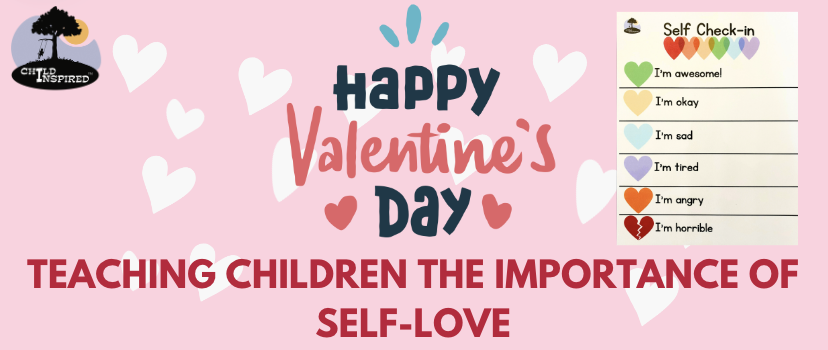Teaching Children the Importance of Self-love

February 14th is a holiday celebrated by many… Valentine’s Day! Valentine’s Day is a day to celebrate LOVE. Around this time of year, children may start noticing red and pink hearts, candy, treats, and decorations around the community. Your child’s class might be having a Valentine’s themed party. Family and friends might send cards and notes called “Valentines” or chocolates, flowers, and gifts. Valentine’s Day is a great day to teach children about love. This holiday can not only teach children how to express love to others, but how to love themselves. This is called self-love. “It is as important for children to build the ability to show love to those who are dear to their hearts, as to know how to love themselves.” (Kvaroy Arctic) How can we teach children about daily self-love? Child Inspired’s Ready to Go Visual: Self-Check-In can help!

Self-check-in is the ability to check in with your body’s emotions. Child Inspired’s Self-Check-In visual is a simple and effective way to teach children to check in with their emotions regularly. Children can grab a sticky note and pencil to move their name tag or place the check-in visual in a sheet protector and use dry erase marker to write their name next to the heart that best describes how they are feeling (ex: pink heart= feeling great, blue heart= feeling sad). This check-in can be used as needed to support emotion regulation (ex: morning and after school check in or when starting to get frustrated or upset use it as a tool before having a tantrum).
Knowing how to check-in with your emotions is a critical skill that both educators and parents/ guardians can help children implement into their daily routines. As a special education teacher, I utilize a self-check-in poster daily with my students. Each morning, when students arrive, they move their name tag to the statement that best fits how they are feeling. This not only helps students begin to apply words and meaning to their emotions, but it also creates an open dialogue between the teacher and student. The self-check-in routine gives me insight into how each students day is starting and makes me more aware of what my students might be dealing with in their home lives. The self-check-in is a tool that can be used any time throughout the day. “Check-ins can be formal and structured, or informal and on the fly.” (Boys & Girls Club of America) Students in my classroom have the option to move their name tag as frequently as needed. If I see that a student has checked in at “sad” or “mad” it shows me that kiddo needs extra love and support. I often ask my students “what steps can we take today to move your name tag up?” Creating a self-check-in routine creates an opportunity for educators and parents/ guardians to be a positive voice in a child’s day.
Top 3 Reasons to Use a Self-Check-In System In Your Home Or Classroom:
- Helps children identify their emotions: It is important to remember that “emotional check-ins may not come naturally for everyone. Some people wear their heart on their sleeve and others need to do some digging to recognize how they’re feeling.” (Boys & Girls Club of America) For most children, learning emotion words is a brand new skill that needs guidance and practice. Self-check-ins are a great start in teaching children how to identify how they are feeling. When pausing and reflecting, children can begin to put words to their feelings. This helps children begin to learn that there are a wide range of emotions and helps children start to see that emotions can change throughout the day.
- Helps create a foundation of self-love: Teaching children to check-in with their feelings and to become self-aware takes time. “Self-awareness is a foundational social-emotional skill that helps us understand how we’re feeling, why, and what we need to be at our best.” (Pathway 2 Success) It is important to teach children this skill with intention. Completing a self-check-in with intention gives meaning to the process. This shows children at an early age that they can use this practice throughout their lives. “Many kids and teens struggle to identify and express their emotions in a healthy way.” (Boys & Girls Club of America) Self-check-ins help children and teens understand their feelings and build critical self-help and coping strategies for the future. Starting a self-check in routine at an early age normalizes and fosters self-love.
- Helps children feel supported, cared for, and heard: Self-check-ins help educators and parents/ guardians know how children are feeling without children having to verbally express their emotions. Self-check-ins can be the first step for children who have difficulty verbally expressing their feelings, may feel uncomfortable or embarrassed, or who are too upset to talk. Implementing self-check-in routines in your home or classroom creates a safe environment where kids can be vulnerable and feel supported. Children and teens need to know who they can talk to in times of need and need to identify who they can feel safe confiding in. “When kids feel comfortable expressing their emotions, they are more likely to build supportive relationships with others.” (Boys & Girls Club of America) This includes children sharing their feelings not only with parents and teachers, but also with friends and other relationships that they may have throughout their lives. In the long run, this builds the foundation for healthier and stronger relationships and communication in the future. Teachers and parents/ caregivers have a responsibility to be consistent and proactive when teaching their children about feelings and challenges, and practicing daily self-check-ins is an easy way to start!
“One important takeaway when learning about an emotions check-in is that it’s something we all benefit from; every child, teen, and adult can gain benefits from pausing, checking in with themselves, and talking about emotions.” (Pathway 2 Success)

Authored by Lexi Gooch, Family Education Specialist
Child Inspired is an emerging family-centered, pediatric wellness practice in Southern Delaware . We are so proud of the inspiring group of pediatric therapists and educators that are working collaboratively to bring help and healing to children and families with in-home, outpatient therapy services and community outreach initiatives. The Child Inspired team takes their work very seriously, but does make sure to sprinkle in moments of silliness and laughter, as we all need strategies to cope with the various challenges we must navigate.
Thanks for being part of our community! We’d love to hear from you!

